#Egyptian mummified remains
Explore tagged Tumblr posts
Text
Author & Timestamp: Sarah Kuta for Smithsonian Magazine, April 30, 2024.
Note: this is an emotive topic and it is not one I feel qualified to give an opinion on yet. My sharing of this extract and link neither supports nor argues against any particular viewpoint, it's simply to take note of a conversation that I feel is important.
Extract:
[T]he��Chau Chak Wing Museum at the University of Sydney [has] removed fragments of mummified bodies from public display. Museum staffers also plan to rename the “Mummy Room” to more accurately and respectfully reflect mummification’s significance in ancient Egyptian culture.
[...]
Egyptologist Melanie Pitkin, [...] a senior curator of antiquities and archaeology [at Chau Chak Wing], is leading the charge to rethink how the museum displays and interprets its Egyptian collection.
[...]
“For hundreds of years, body parts in museum collections have been treated as objects,” says Pitkin in a statement. “We have become so accustomed to seeing them on show that we often forget they once belonged to living people.”
For now, the remains are being kept in the museum’s “closely monitored collection store” while curators work to “implement better practices with Egyptian communities and authorities,” according to the statement. In the display, the museum replaced the unwrapped body parts with ancient Egyptian funerary portraits from coffin lids and masks. Curators are also exhibiting a painted portrait from the Roman era.
[Two] completely wrapped, mummified bodies [...] along with 3D visualizations based on CT scans of the remains. The CT scan data of another mummified body [...] also remains on view.
[...]
“In renaming the room, we’d like to focus more on the transformation of the body into an eternal being [...], rather than the body itself,” Pitkin says [...]. “We also encourage visitors to critically reflect on the ethical complexities museums face when caring for human remains.”
[...]
“[Modern] cultural stereotyping [of ancient Egyptian mummified bodies] would elsewhere be recognized as a form of racism, but the ancient Egyptians are not here to object to the ways in which we depict them,” Jasmine Day, an Egyptologist [...], tells the Sydney Morning Herald.
[...]
Around the world, curators and policymakers are also reconsidering their approaches to other types of artifacts. Earlier this year, [...] Harvard University removed a book binding made of human skin from its library, while the Field Museum in Chicago covered some of its Native American artifacts.
/end of extract
#important discussions#academic debate#museum politics#curation#mummified human remains#human remains#history#ancient#archaeology#museum news#Chau Chak Wing Museum#University of Sydney#Australia#mummified bodies#ancient Egyptian#museum displays#ancient Egyptian artifacts#museum collections#egyptology#antiquities#curators#academic ethics#ethics#mummification#Egyptian mummified remains#ethical considerations#ancient Egypt#cultural stereotyping#smithsonian#academic discourse
1 note
·
View note
Text
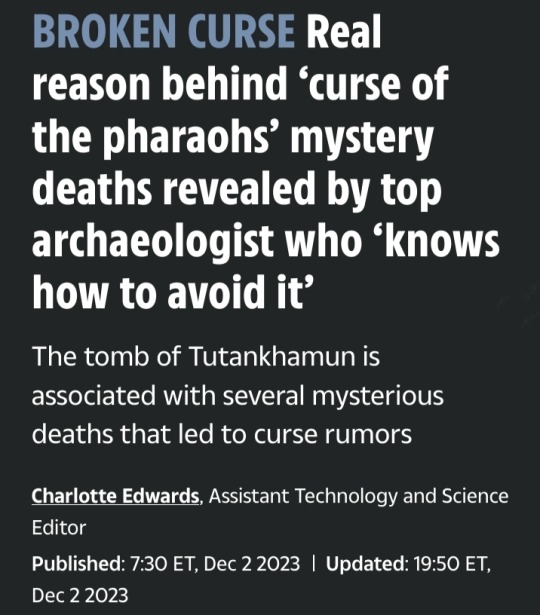
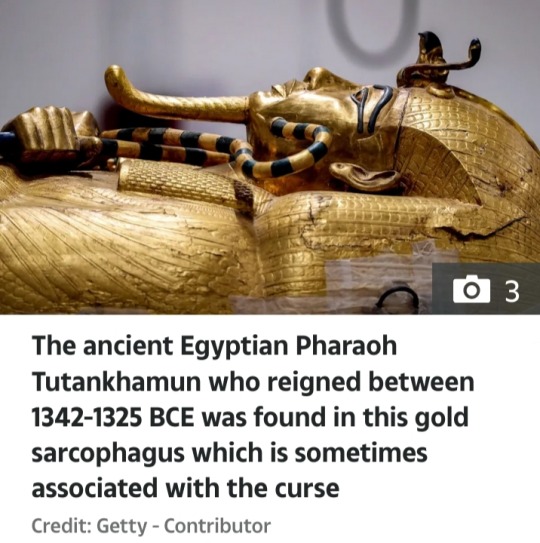
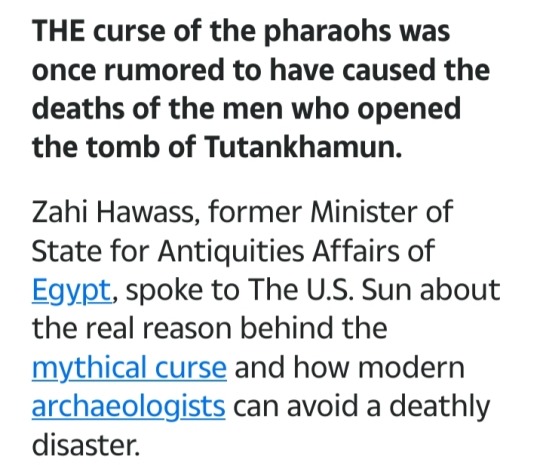
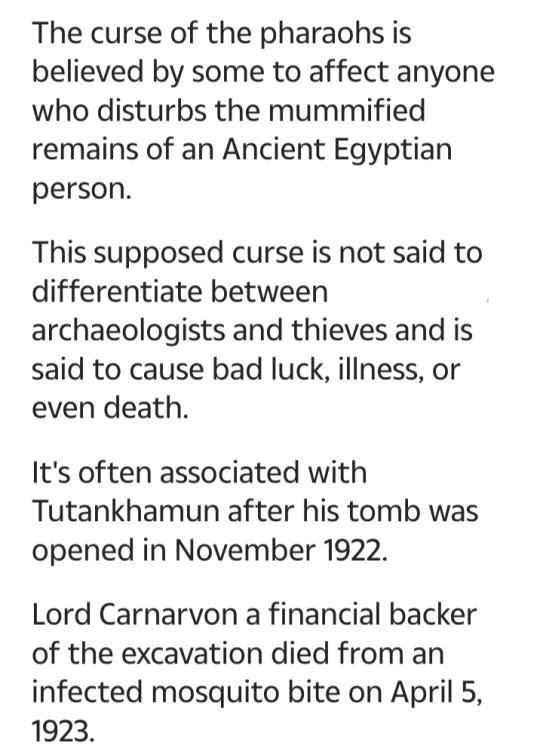
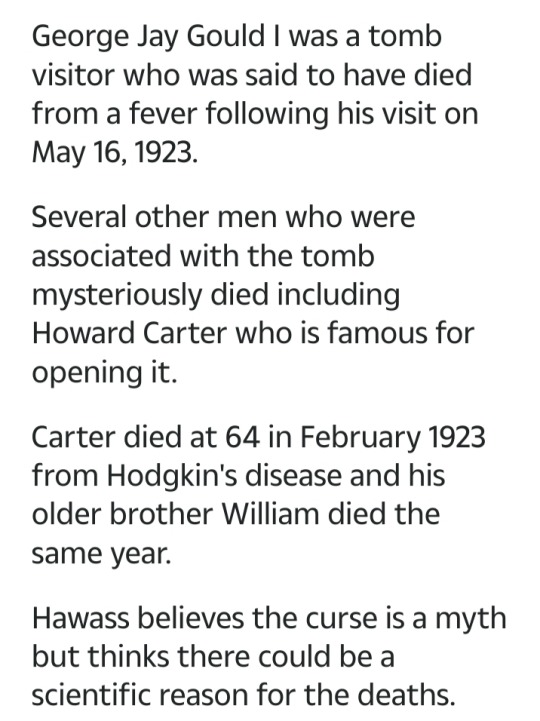
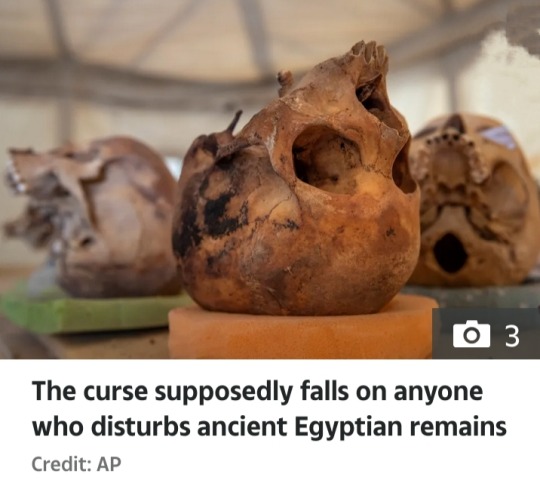
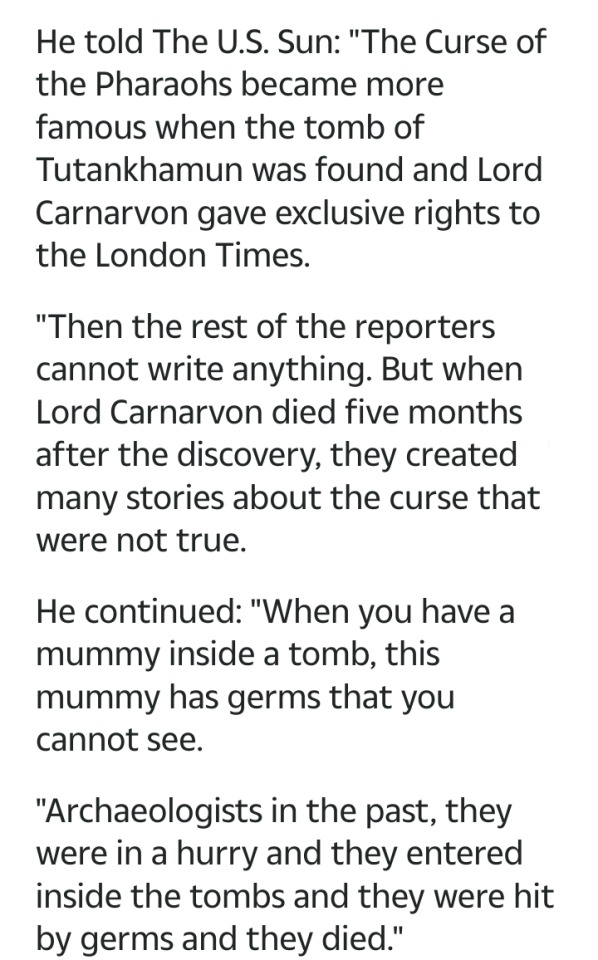
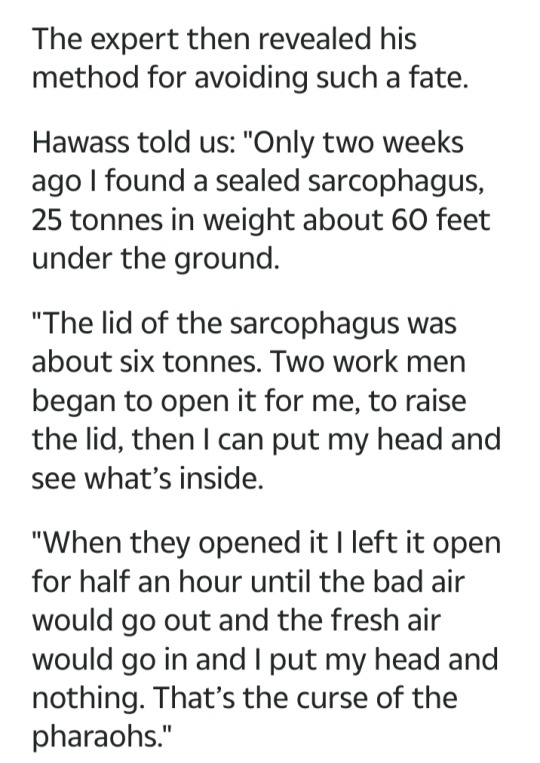

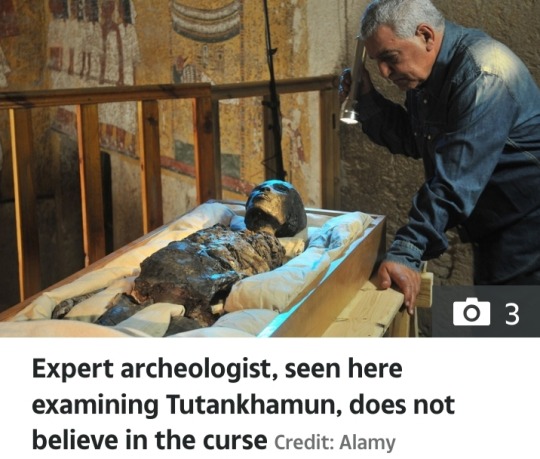
#Tutankhamun#Tomb of Tutankhamun#curse of the pharaohs#Ancient Egypt#Ancient Civilization#Dr Zahi Hawass#Minister of State for Antiquities Affairs#Egypt#mythical curse#archaeology#sarcophagus#mummified remains#Lord Carnarvon#Howard Carter#George Jay Gould I#mummies#germs#curse#Ancient Egyptian Pharaoh
62 notes
·
View notes
Text

The "screaming mummy" refers to an ancient Egyptian woman whose mummified remains were discovered in 1935 during an archaeological expedition in Deir el-Bahari near Luxor, Egypt. This unknown woman was estimated to have lived around 3,000 years ago. She is notable for her facial expression, which appears to show a mouth open in a scream or cry.
Recent studies suggest that her contorted facial expression might indicate she died in extreme agony, possibly due to a painful execution or severe illness.
194 notes
·
View notes
Text
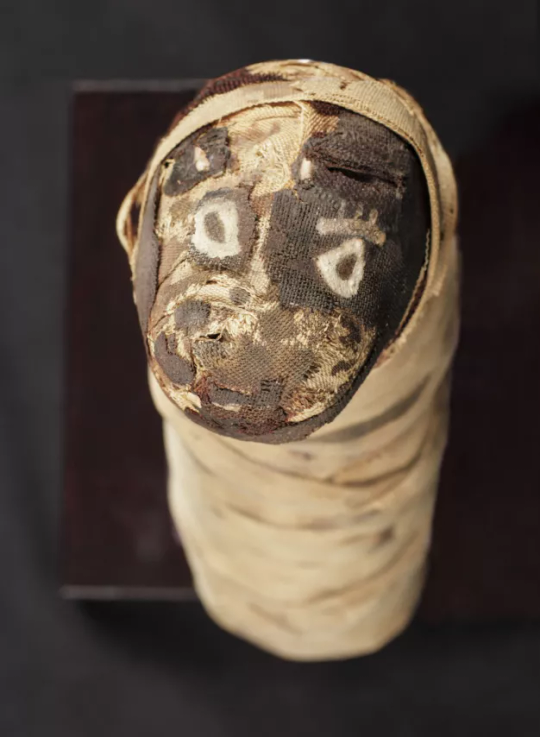
~ Mummified Dog.
Culture: Egyptian
Period: Roman Period
Date: ca. 30 B.C.–A.D. 395
Medium: Linen, pigment, and organic remains.
#ancient#ancient art#history#museum#archeology#ancient egypt#ancient history#archaeology#egyptology#Egyptian#egypt#mummy#mummified#mummified dog#Roman#roman period#dog#ca. 30 b.c.#ca. A.D. 395
805 notes
·
View notes
Text
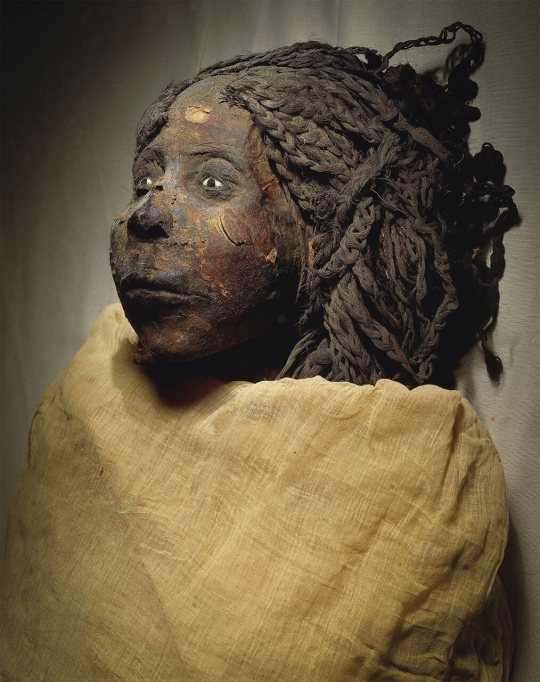
The mummified remains of Queen Nodjmet
Third Intermediate Period, 21st Dynasty, ca. 1069-945 BC. Now in the Egyptian Museum, Cairo. JE 26215
The mummy of Queen Nodjmet was found in the Deir el-Bahari Royal Cachette (DB320). The mummy had been given artificial eyes, made of white and black stones. The eyebrows are real hair and she wears a wig. Her body and parts of her face were colored to give her a more lively appearance.
Nodjmet was an ancient Egyptian noble lady of the late 20th Dynasty or early 21st Dynasty of Egypt, the wife of Herihor, High Priest of Amun at Thebes. She may have been a daughter of Ramesses XI. Early in her life, she held titles such as Lady of the House and Chief of the Harem of Amun.
Read more
325 notes
·
View notes
Note
Spaniards ate mummies in the Canary Islands?! WTF?
Mummia, a substance created from ground mummies was a popular medicine and aphrodisiac in medieval Europe and when it fell out of practice as a medicine, it was still used as a pigment in oil painting until the 1800s. Typically made from Egyptian mummies, Egypt banned the export of the substance in the 16th century.
The Spanish colonized the Canary Islands in the early 15th century and began making mummia out of the mummified remains of the Guanche people, who had inhabited the islands for upwards of 2,500 years at the time of Spanish arrival. The destruction was so total that less than 20 Guanche mummies remain in the whole of the Canary Islands. We cannot say for certain that the thousands of missing mummies were used for mummia, the Spanish may have simply desecrated and destroyed them.
66 notes
·
View notes
Text
Mythology Fact #1 - Sobek, Egyptian Crocodile God
NEW SERIES! Mythology Facts will explore many elements of world mythologies, but with a particular focus on Greek, Egyptian, and Norse, especially at the start.
Easily the winner of the first poll about this new series as held on my Patreon is Sobek, the ancient Egyptian crocodile-headed god!
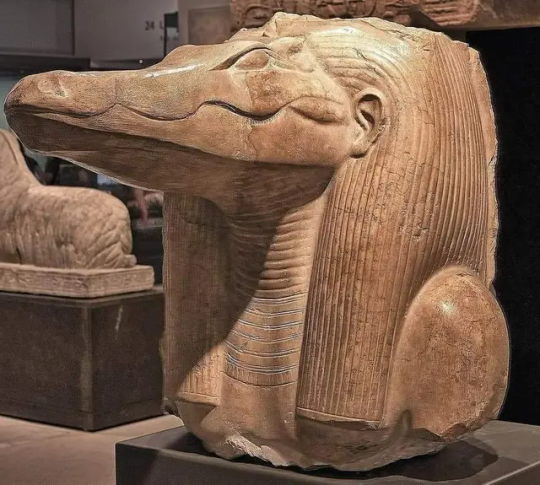
Head of a limestone statue of Sobek, as previously on display at the Met as part of a special collection; Met info on the statue head here
In ancient Egypt, like many ancient cultures, the most fearsome of beasts were highly regarded for their awe-inspiring endurance, power, and ferocity - a concept often little-understood today, as animals are now often seen as obstacles to be conquered or put out of the way, hence why it can occasionally be difficult to detail to the modern mind the relationship between men and wolves throughout history (but I'm not on that right now, so I'll stop). The people of ancient Egypt held great reverence for many animals, not least among them being the obviously very dangerous crocodile.
An integral part of life in ancient Egypt was the rise and fall of the Nile. Sobek was a centerpiece of the Nile life - crocodiles were abundant, a testament to their fertility and virility, and they were fearsome, strong, and enduring. Sobek's nature is intensely complex and his "domains," as we so often think of deities as having, were extensive, including but not limited to fertility, virility, illness, health, strength, pharonic power, military might, protection (especially protection from, essentially, bad luck), and the dangers and wonders of the Nile. By nature, he was considered animalistic, unpredictable, strong, protective but dangerous, and highly sexual, aspects frequently associated with the most powerful predators in a given region (notice all those things are also associated with wolves). Sobek was depicted variably as a crocodile and a crocodile-headed man, and holy crocodiles were kept in his name.
Given his association with the Nile and so many other things, Sobek was and mostly remained a very important figure, especially with his later fusion with/association with both Horus and Ra, two extremely important deities...
This is quite the lengthy post! More under the cut.
Among many other things, Sobek was said to have power of the fertility of the Nile's soil, as well as its waters, and thus also had great power over disease, as the Nile could also cause illnesses. Like so many ancient Egyptian deities, Sobek also had an association with the dead, being called upon to bring them sight and return their senses in the afterlife, as well as to assist in protecting them (along with many other deities, including but certainly not limited to Isis, Nephthys, and Anubis).
Sobek's strong association with fertility is found in his many epithets and even the name we use for him most - "Sobek" is thought to perhaps even come from a causative of "to impregnate" (though some scholars contend it instead means "to unite," especially in relation to the pieces of Osiris). Perhaps the first instance we have of Sobek in a text comes from the Pyramid Texts, in which a spell refers to Unis (the pharaoh) as a living incarnation of Sobek - the pharaohs were very often living incarnations of assorted deities at various times - and says that Unis "will copulate" very specifically and that he is the lord of something that would probably get this post censored, "who takes women from their husbands to the place Unis likes according to his heart's fancy."

Mummified crocodiles found in the Temple of Kom Ombo; we have found mummified crocodiles of all ages, even including fertilized eggs
Now let's talk about a thing called the petsuchos. Mummified crocodiles served as images of Sobek in various forms, one of which being Petsuchos, meaning "son of Sobek." It is thought one crocodile in particular took on the aspect of the petsuchos and was kept in Shedet, replaced by a new petsuchos whenever the previous died. Following the death of a holy crocodile, a great ritual took place to mummify the creature and then put it on display, as it remained ever sacred. Living crocodiles were sometimes kept in other temples and holy places, even including outdoor pools. They were adorned with gems and fed delicacies; some were even considered attractions, as feeding the holy crocodile brought good luck, given Sobek's apotropaic nature. There was even a divine crocodile breeding center established by Amenhotep III (who pushed the Sobek cult quite energetically).

There are many depictions of Sobek found throughout what we have of ancient Egypt, including many of its time periods. He is perhaps one of the oldest gods of ancient Egypt, having appeared as early as during the reign of King Narmer in the first dynasty. His importance during the Old Kingdom, as well, can be found in the Pyramid Texts. The entire region of Fayum was a cult center of Sobek, so great was his importance, the seat of which was - of course - the capital, Crocodilopolis or Shedet.
Also very worthy of note is Sobek-Ra, a combination of the gods Sobek and Ra, that appeared in very late-age Egypt in the New Kingdom (1150-1069 BC), and even continued into the Ptolemaic Period (around 332 BC to 390 AD). Sobek-Ra (or Sobek-Re if you want to go that way) may have first appeared during the reign of the first king of the Middle Kingdom, Montuhotep II, as addressed in the Coffin Texts used during the Middle Kingdom (in which Sobek is addressed as "he who rises in the east and sets in the west"). As a combination, depictions thereof often had the head of a falcon but the body of a crocodile, often wearing the solar disc and uraeus (cobra).
He combined aspects of both deities, which is also perhaps thanks to Sobek's association also with Horus. When Horus took on the aspect of a crocodile during his retrieval of Osiris's bodyparts, Sobek became associated with him, even considered an aspect of Horus. Likewise, however, Sobek also was said to have assisted Isis during Horus's birth. Such deity fusions, aspects, and deities becoming an aspect and/or appearing in various myths in nebulous forms were not uncommon in ancient Egypt, and Sobek was also combined with Horus at assorted other points. All of this continues to point to the association between Sobek and kings (pharaohs), especially when you reach the point of learning about Sobek of Shedet-Ra-Horus, but I won't go into all that here due to time constraints.
So, obviously, there's so much more to say that it's, frankly, crazy and almost overwhelming. The study of ancient Egypt is a complex undertaking, hence why we have an entire field called Egyptology. So, consider this very much a simplified overview. Hope you enjoyed the post!
And stay tuned for news and updates on a major [werewolf/fantasy/adventure/horror/epic] book release later this year! Likewise, if you enjoy mythology in general and Egyptian myth, be sure to check out my other works of fiction, including this one here--also available on Amazon.com and many other retailers. Sequel coming next year.
If you like my blog, be sure to follow me here and elsewhere for much more folklore and fiction, including books, especially on werewolves! You can also sign up for my free newsletter for monthly werewolf/vampire/folklore facts, a free story, book previews, and my other sundry projects and works.
Free Newsletter - maverickwerewolf.com (personal site + book shop) — Patreon — Wulfgard — Werewolf Fact Masterlist — Folklore Fact Masterlist — Mythology Fact Masterlist — X — Vampire Fact Masterlist — Amazon Author page
#mythology#myth#egyptian myth#egyptian mythology#ancient egypt#egypt#crocodile#crocodiles#the nile#nile#sobek#folklore#legend#egyptian deities#egyptian gods#mythology fact#history#egyptian history#research#fiction#Wulfgard#long post
68 notes
·
View notes
Text






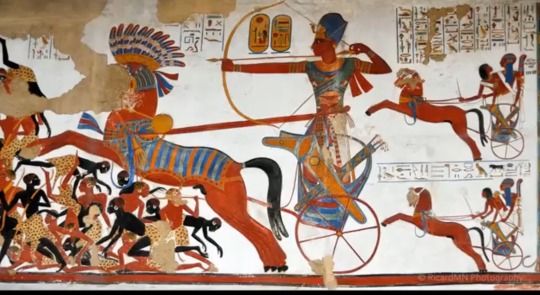
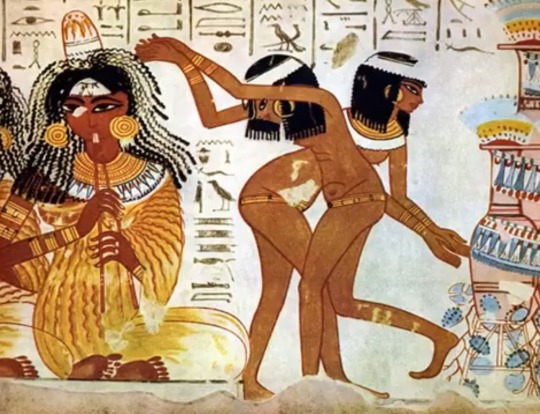

Ancient Egyptians were African: Debunking Myths and Addressing Anti-African Narratives
For centuries, the identity of the ancient Egyptians has been hotly debated, with Eurocentric and anti-African narratives attempting to erase their African origins. Claims that ancient Egyptians were not African but rather European, Middle Eastern, or Mediterranean in origin are not only historically unfounded but also rooted in racism, colonialism, and a deliberate effort to disconnect African people from their cultural and historical achievements.
This analysis will explore why these claims are nonsensical, delve into their anti-African roots, and demonstrate that ancient Egyptians were fundamentally African, with no credible links to Europe or the Mediterranean as their cultural or racial origin.
1. The Geographic Reality: Egypt is in Africa
Africa’s Geography Is Non-Negotiable
Egypt is located in the northeastern corner of Africa, bordered by Sudan to the south, Libya to the west, and the Sinai Peninsula to the northeast. It is geographically part of the African continent.
The Nile River, which was the lifeline of ancient Egyptian civilization, flows through other African regions, linking Egypt with its sub-Saharan neighbours.
Cultural Context in African History
In ancient times, Egypt was deeply connected to the rest of the African continent. Trade, migrations, and cultural exchanges with Nubia, Kush, and other African regions were foundational to Egypt’s development.
The claim that Egypt is somehow "separate" from Africa is a modern fabrication rooted in Eurocentrism.
Garveyite Perspective
Marcus Garvey emphasized the unity of African peoples and their shared cultural heritage. To detach Egypt from Africa is to deny the historical contributions of African civilizations to global history.
2. Physical Anthropology: African Traits of the Ancient Egyptians
Skeletal and Cranial Studies
Anthropological studies of ancient Egyptian remains consistently demonstrate features characteristic of indigenous African populations, including cranial structures, nasal cavities, and other markers commonly found in East Africans and Nubians.
Mummified remains, including DNA analysis, confirm that the ancient Egyptian population had genetic ties to sub-Saharan Africa, particularly along the Nile corridor.
Depictions of Themselves
Ancient Egyptians depicted themselves in artwork with dark brown skin tones, distinct African features, and hairstyles like braids and cornrows—styles still prevalent in African communities today.
Garveyite Perspective
Garvey believed in reclaiming African identity and history. These physical and cultural markers of the ancient Egyptians reaffirmed their African roots, undermining attempts to Europeanize or de-Africanize their identity.
3. Cultural Continuity With Other African Civilizations
Connections with Nubia and Kush
Nubia (modern-day Sudan) was a close cultural and political partner of ancient Egypt. The Nubians shared linguistic, religious, and artistic traditions with the Egyptians.
Egypt’s earliest dynasties were heavily influenced by Nubian traditions, and Nubians often ruled Egypt (e.g., the 25th Dynasty).
Shared Religious and Spiritual Practices
Many ancient Egyptian religious beliefs—such as ancestor worship, reverence for the Nile, and solar worship—align with other African spiritual systems. These traditions reflect an African worldview, not a Mediterranean or European one.
Garveyite Perspective
Garvey emphasized Pan-African unity. Recognizing Egypt’s connections with other African civilizations strengthens the narrative of African greatness and shared cultural heritage.
4. Why the "Non-African Egypt" Narrative Exists
Colonialism and White Supremacy
European colonizers sought to portray Africa as uncivilized and incapable of high achievement. To justify slavery and colonialism, they disconnected Egypt from Africa to present African peoples as inferior.
Napoleon’s invasion of Egypt in 1798 marked a turning point where Europeans claimed Egyptian history as their own, deliberately misinterpreting evidence to align with white supremacist ideologies.
Pseudo-History and Egyptomania
During the 19th and 20th centuries, Western scholars promoted ideas that the Egyptians were white or Mediterranean, often citing flawed archaeological interpretations or cherry-picked data.
Popular culture reinforced these ideas, portraying ancient Egyptians as white in films, art, and media.
Anti-Blackness and Cultural Erasure
The denial of Egypt’s African identity is part of a broader trend of erasing Black contributions to history. By detaching Egypt from Africa, these narratives deprive African people of one of their most significant cultural legacies.
Garveyite Perspective
Garvey fought against colonial narratives that demeaned African peoples and erased their history. He would view the de-Africanization of Egypt as a deliberate attack on African pride and identity.
5. Ancient Egyptians Had No Links to Europeans or the Mediterranean
Minimal Contact With Europe
For most of its history, Egypt had little to no interaction with Europe. It was geographically and culturally oriented toward Africa and the Near East.
When Greeks and Romans did arrive in Egypt (around the 4th century BCE), they came as invaders or occupiers, not contributors to its development.
Distinct Cultural Traits
Ancient Egyptian art, language (hieroglyphics), and architecture show no foundational influence from Europe. These cultural markers are distinctly African and predate European civilizations like Greece and Rome.
Genetic Evidence
Studies of ancient Egyptian DNA reveal minimal genetic overlap with Europeans during the Pharaonic period. Most genetic links are with sub-Saharan and East African populations.
Garveyite Perspective
Garvey believed that African civilizations existed independently of Europe. The idea that Egypt is tied to European history is a colonial fantasy designed to undermine Africa’s achievements.
6. The Mediterranean Myth
Misrepresentation of the Mediterranean
The term “Mediterranean” is often misused to imply European influence in Egypt. While Egypt did trade with Mediterranean civilizations, this occurred primarily during the Late Period, long after its cultural foundations were established.
The Mediterranean was a crossroads for African, Asian, and European interaction. However, Egypt’s primary cultural influences were African, not Mediterranean.
Linguistic Evidence
The ancient Egyptian language is part of the Afroasiatic language family, connecting it to other African languages like Hausa, Berber, and Amharic. This linguistic link further cements Egypt’s African identity.
Garveyite Perspective
Garvey’s vision of African pride and independence rejects the Eurocentric framing of history. The Mediterranean myth is another attempt to obscure the truth of Egypt’s African heritage.
7. Why It Matters: Reclaiming African History
African Pride and Unity
Recognizing Egypt as an African civilization inspires pride in African heritage and counters centuries of colonial propaganda.
Egypt’s achievements—pyramids, medicine, mathematics, and governance—showcase the genius of African people.
Combatting Racism and Erasure
By reclaiming Egypt as African, we challenge the racist narratives that have historically dehumanized Black people and undermined their contributions to global history.
Garveyite Perspective
Garvey’s Pan-Africanism is rooted in the belief that African people must reclaim their history, culture, and identity to achieve true liberation. Egypt is a cornerstone of that history.
Conclusion: Ancient Egypt Was, Is, and Will Always Be African
The argument that ancient Egyptians were not African is nonsensical, unscientific, and rooted in anti-African bias. Egypt is geographically, culturally, and historically African, with no foundational ties to Europe or the Mediterranean.
From a Garveyite perspective, reclaiming Egypt as African is essential for restoring pride, unity, and identity among African people worldwide. As Marcus Garvey proclaimed:
"Africa for the Africans, at home and abroad."
It’s time to honour Egypt as part of Africa’s rich legacy and reject the colonial lies that seek to divide and diminish Black history.
#black people#black history#black#black tumblr#blacktumblr#pan africanism#black conscious#africa#black power#black empowering#ancient egypt#african history#african civilization#marcus garvey#african identity#black community#black pride#black diaspora#african diaspora#anti colonization#anti blackness#white supremacy#cultural reclamation#african people#african culture
31 notes
·
View notes
Text
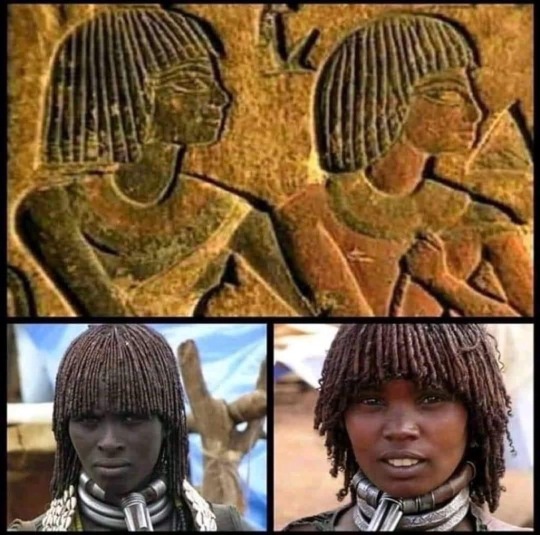
Some of the earliest depictions of dreadlocks or Sacredlocks date back as far as 1600–1500 BCE. In ancient Egypt, examples of Egyptians wearing locked hairstyles and wigs have appeared on bas-reliefs, statuary and other artifacts. Mummified remains of Egyptians with locked wigs have also been recovered from archaeological sites. This culture is still carried on today in Africa.
50 notes
·
View notes
Text
(EMMRICH/MW) CAT CANONS (p2?!)
Note: wow, wasn't expecting everyone to enjoy the cat canons so much! Thanks for all the likes and reblogs everyone!
HAVE SOME MORE CAT CANONS.
Based on the food and culture, I'd like to think Nevarra has some roots in Greek and Turkish culture. Just like Ferelden is big on dogs, Nevarra is big on cats. It isn't surprising to see a family in Nevarra owning a cat or two. Noble families tend to own more exotic cat breeds, like a Bengal, Egyptian Mau or Abyssinian.
Some family members would request to have the remains of their cats buried with them. Cats are seen more like family rather than just a pet in Nevarra. Nobles may pay extra to ensure their precious fur babies are mummified and interred in the family crypt. Some nobles even build little sarcophaguses for the cats!
The Necropolis will take in cats if families surrender the cat of a loved one or if the family of that cat is no longer available. These cats are brought in to join the Necropolis cat colony. The cats that roam the upper levels of the Necropolis are cared for and inspected regularly by the Mourn Watch.
There is a log containing records of all the cats which joined the Necropolis cat colony. It includes details such as the the date the cat was brought in, cat's name, physical description, personality, date of death and where their remains are stored after their death. There is a crypt specifically for cats who are part of the Necropolis cat colony.
It is not unusual for wisps of curiosity to inhabit the remains of a deceased cat. Sometimes the wisps simply may take up the form of a cat. Wisps in cat form! Emmrich believes that the spirit of some cats never truly go away, likely becoming wisps of curiosity as most cats are very curious by nature.
If Rook is from the Mourn Watch, it is likely they have encountered Gregory and Douglas before. When Rook and Emmrich return to the Necropolis together to perform the candle ritual, Gregory and Douglas recognizes Rook. Both of them greet Rook eagerly. A romanced Emmrich pouts as he realizes that the cats favor Rook more than him.
Emmrich is known to take time out of his schedule to check in on the health of the cats. He makes sure that they are healthy, teeth are in good condition and their fur is soft and clean. He has a drawer of grooming brushes, each with different textures in case the cat has a preference. Caring for the cats allows Manfred some interaction time, which Emmrich believes is good for Manfred's development.
Manfred likes it when a cat rests on him and purrs. He tried to replicate the sound several times but has not been able to purr successfully. He ends up making a loud hissing sound which startles the cats.
Manfred's first interaction with a cat caused him to pick up the bad habit of pushing things on tables to the ground. Emmrich is glad Manfred has stopped since.
#emmrich volkarin#dragon age the veilguard#emmrich x rook#emmrook#dragon age emmrich#cat canon#mourn watch rook#mw!rook#manfred dragon age#manfred the skeleton#I HEAR WE LIKE CAT CANONS?
25 notes
·
View notes
Text
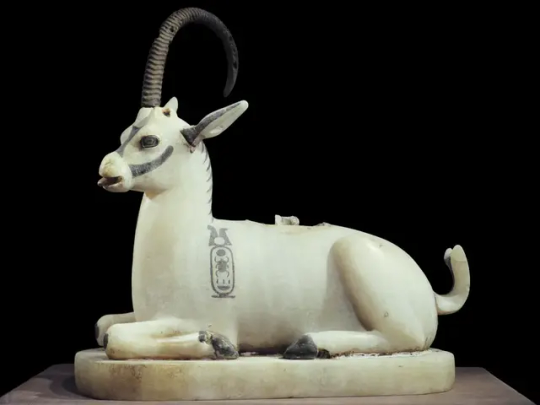
[ A jar in the shape of an ibex, retaining one natural horn, found in the tomb of the pharaoh Tutankhamun. Photographed by Robert Harding. ]
"Millennia ago, northern Africa was much wetter and cooler. Monsoons struck periodically, and the Sahara was covered with lakes and vegetation. This greener version of Egypt was home to a mix of wildlife more like the one now found in East Africa, with 37 species of large mammals including lions, wildebeest, warthogs and spotted hyenas. The region began to dry out about 5,000 years ago, a time that coincides with the fall of the Uruk Kingdom in Mesopotamia (located in present-day Iraq) and the rise of the pharaohs in Egypt. The Egyptian people at this time switched from a mobile, pastoral life to one of agriculture and subsistence hunting. The new research shows that several species of antelope, along with giraffes and rhinoceroses, disappeared around the same time—extinctions that could be due to overhunting of herbivores. Shortly afterward, the long-maned lion vanished. Egypt became even drier around 4,200 years ago, during a time known as the “First Intermediate Period” or the “dark period.” The region depended on yearly flooding of the Nile to inundate the land and leave behind nutrient-laden silt to feed agricultural fields. But during the dark period, this flooding became inconsistent, crop yields dropped and famine ensued. War and chaos reigned, and eventually the Old Kingdom—and with it, the “Age of the Pyramids”—ended. This is when the roan antelope and African wild dog disappeared from the records. A third aridification event occurred about 3,000 years ago, again bringing drought and an end to the New Kingdom, a time that included Tutankhamun and 12 kings named Ramses. Egypt’s short-maned lions, revered as sacred and even occasionally mummified, vanished around this time. Then about 150 years ago, as Egypt’s growing population became more industrialized, more species disappeared, including leopards and wild boar. Today, only 8 of the original 37 large-bodied mammals remain."
- Excerpt from "Egypt’s Mammal Extinctions Tracked Through 6,000 Years of Art" by Sarah Zielinski.
122 notes
·
View notes
Text

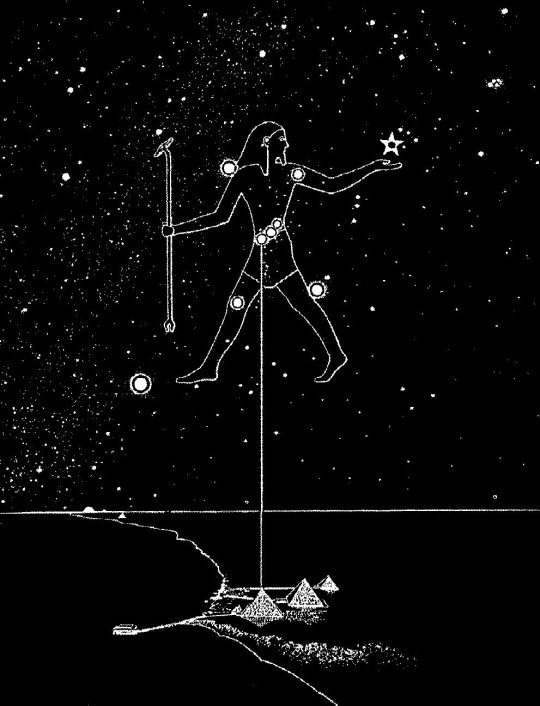
Orion's belt aligned with the Giza pyramids. Al Nitak points to the Great Pyramid. The gods left many signs using mathematics and astronomy, especially those signs built into the Great Pyramid.
Lions Gate Portal 8/8
August 8th, known as the Lions Gate, has been revered for several thousand years as the date that marks the peak of an influx of high-frequency energy onto planet Earth from the star Sirius, which is in its closest proximity to earth from July 26th through August 12th – the full period of the Lions Gate opening or Galactic New Year. Second in brightness only to the sun, to Ancient Egyptians this star was revered as their “Spiritual Sun” and referred to as Auset’s star Sopdet – Spdt, meaning “she who is sharp.”
The Lions Gate is the annual season when Spdt comes into her most pristine alignment with Re [the Sun], Geb [the Earth], and Sah – the Hunter constellation identified with ancient Egypt’s King Ausar – called Orion in Greek. During this cosmic portal, Sopdet – the spiritual Sun – emits an ancient activating energy so powerful as to cause the annual inundation which has sustained Nile River Valley communities over several millennia, whilst spurring the collective ascension of human consciousness throughout earth – the land or house of Geb/Keb. As God Djehuti proclaimed, “If the truth must be told, this land is indeed THE TEMPLE OF THE WORLD…” The August 8th peak of the Lions Gate is when Sopdet is said to perfectly align with the shaft from Queen Auset’s Chamber within the Great Pyramid of Giza, in concert with that from King Ausar’s Chamber aligning with Alnitak, one of the three stars of the Hunter constellation’s belt. Known as the “3 Wise Men” or the “3 Sisters,” these three stars form the cosmic blueprint from which the complex known as the Pyramids of Giza was built.
“As above, so below… As within, so without” are codes which remain key to Kemet’s ancient Mystery System. Thus, the Nile River represents the Milky Way (called Maziwa Mkuu in Kiswahili, meaning ‘great milk’) on earth ‘below’ as in heaven ��above’. Two lions are said to hold open this magnificent time-space portal, one of which is represented by the Great Sphinx whose figure is an earthly representation of the constellation of Leo and a key piece of the puzzle of relationships within the Milky Way galaxy ‘above & below’. Lying on the west bank of the Nile river, the Great Sphinx is poised with its tail to the west [where the sun exits] as it faces directly east towards the sun’s reentry. The Lions Gate [7/26 – 8/12] opens within the astrological season of Leo, adding to the influx of regal energy from the alignment between Earth and the Universe’s Galactic Center, which reaches its peak on 8/8 over African soil. It is a powerful reminder of Heaven-on-Earth’s potency, symbolized ‘within & without’ through the quintessential Divine Love that exists between cosmic Hunter Ausar and his earthly Gatherer, Throne Queen, and Spiritual Sun – Auset.
According to the mythology of Ausar-Auset, in a jealous bid to usurp their Heaven-on-Earth throne, Set murders King Ausar, dismembering his body into 14 parts and scattering them in the wilderness [African Diaspora] so as to prevent his resurrection and return. Set the antagonist is god of chaos, foreign oppressors, violence, perversion, illness, and the desert who caused Egypt to be widowed of the gods and humanity to be trapped in his false predatory & parasitic matrix. After widow Auset searches the wilderness and manages to retrieve and mummify only 13 of her husband’s mutilated body parts, it is up to Heru, her posthumously/immaculately-conceived son with King Ausar, to become the Warrior who avenges his father’s fate and restores divine order to the kingdom by defeating Set…
Pyramid texts speak of Heru as the Great Lion: “Horus who comes forth from the acacia to whom it was commanded: ‘Beware of the lion’. May he come forth to whom it was commanded: ‘Beware of the lion’.” [Pyramid Text 436a-b]
Africa’s Acacia tree, which is sacred to goddess Auset, has long been associated with ancient mysteries including the secrets to life, death, healing, sustenance, and resurrection – hence their organic ties to matriarchal goddesses. Linked to the Akashic Records, the astral ancestral library where everything that has or will ever occur is recorded, the Acacia trees in Heliopolis were thought to have been the birthplace of the very first deities. Heliopolis (called On in Lower Egypt), was the ancient worship center of sun-god Re whose celestial boat was made of Acacia wood in its hind parts (palm wood in its fore-parts). The mythologies of Ausar-Auset are Heliopolitan in their derivation and orientation, e.g. the reference to Ausar as ‘the one in the tree… the solitary one in the acacia.’ This saying was based on the version of their story in which Auset releases her husband’s body from a pillar in Byblos [a prophecy relating to the scripted bible?] that had been fashioned out of the tree which enclosed the coffin King Ausar had been tricked into entering as Set’s ploy to usurp/colonize Egypt’s throne. Symbolizing the immortality of the soul in Freemasonry, the thorny acacia tree otherwise represents Ausar’s backbone, depicted as the Djed Pillar in this particular mythological account.
Trees act as resurrection portals and/or gateways between worlds in ancient Egyptian Mysteries, such as the Sycamores (associated with goddesses Nut & Hathor) through which Re rises as the Sun each day from the east: “I know the two sycamores of turquoise between which Re comes forth, when he passes over the supports of Shu to the gate of the lord of the east from which Re comes forth” [Book of the Dead: Ch. 109]. Auset & Nepthys were regarded similarly as “the two Acacias.” Thus, these Mother Trees act as do the two lions which hold open the portal for the “Spiritual Sun” Sopdet to rise as the consort of Sah during the Lions Gate season, in order to usher forth the blessings of the Galactic New Year with the annual inundation of the Nile River. Their child, hawk god Heru-Sopdu is referred to as “Lord of the East,” thus presaging mythologies surrounding the Ausar-Auset-Heru trinity as archetypal personifications of key spiritual motifs that connect us organically to our higher selves… “As above, so below.”
“As within, so without” is a principle that plays out in the eternal relationship that exists between Ausar-Auset, their love representing a Heaven-on-Earth divine order, which is interrupted by the chaos that Set’s predatory & parasitic rule brings, i.e. until Heru is able to successfully accomplish his Hero’s Journey and restore Ma’at/UbuNtu… unity-consciousness. For Africa, the earthly source and staging of these love-as-salvation narratives, Set is representative of a false matrix built on slavery, (neo)colonialism, apartheid, misogyny, misogynoir, etc. – controlling foreign narratives which have in-formed external elite-run global systems & misled most of humanity into profound states of isolation, alienation, disconnection, and disorientation from organic & natal bonds. Heru – “[the Lion] who comes forth from the acacia…” [Pyramid Text 436a-b] – thus has his work cut out for him.
Again, in this case the acacia reference represents a fascinating organic matriarchal portal between worlds for Heru as a human prototype resident in each of those who do not entertain predatory or parasitic relationships of dysfunctional dependency [read “slavery… apartheid… (neo)colonialism… misogyny… misogynoir…”], but strategically translated into self-referential Europatriarchal scripture as mankind’s singular “savior” [Jesus]. Deep inside Africa – the regal lion‘s natal home – the acacia tree itself has a characteristic dome-shaped canopy due to the way indigenous giraffes graze, which they have to do carefully because the acacia senses this feeding activity and releases tannin, a defensive poison that can kill from the overgrazing of its leaves. The acacia then emits ethylene on the wind, a chemical that alerts other acacia trees to preemptively defend themselves against “predators” by producing tannin also. DMT, a hallucinogen associated with spiritual experiences, is present in various species of the tree such as the Acacia Nilotica.
The Lions Gate represents so much to so many, especially during this dramatic period of humanity’s ascension in 2020 (Gregorian timeline). Feline power, highly revered in Kemet, is front and center as the astrological symbol for Leo and also as the identity of the African goddess annointed as “Opener of Heaven’s Door.” Among her other titles, Goddess Seshat – “Foremost of the per-Ankh” – is also known as the “Panther Goddess” and “She of Seven Points” in reference to her highly emblematic dress and crown, respectively. Appropriated by Europatriarchs in their design of Lady Liberty following America’s post-Civil War end of slavery, Seshat‘s 7-pointed crown has symbolically countered the racist & misogynistic tendencies of false 3D matrix systems. Seshat‘s traditional panther-skin dress returns our consciousness to humanity’s African source and the need to descramble & purge predatory Victorian-era matrix codes which, during the receding Piscean era, morphed into parasitic neo-colonial arrangements, hijacking the human spirit and its potential. These & other ancient unity-conscious codes [UbuNtu] are key to human ascension and Heaven-on-Earth reparations in the dawning age of Ma’at... “Return, return, O Shulamite; return that we may look upon thee…” [SoS 6:13] “Behold, I come quickly: hold that fast which thou hast, that no man take thy crown.” [Rev. 3:11] Blessed Be…
39 notes
·
View notes
Text

Archaeologists Unearth Mummies with Golden Tongues in Egypt
Archaeologists have unearthed several ancient tombs with dozens of mummies—including some with golden tongues.
Researchers made the findings during excavations at the ancient city of Oxyrhynchus, an extensive archaeological site located around 100 miles south-southwest of Cairo near the modern-day municipality of Al-Bahnasa in Minya Governorate.
Oxyrhynchus was "very important" during ancient Egypt's Greco-Roman period, which spanned hundreds of years from the late fourth century B.C. until the 7th century, Esther Pons Mellado and Maite Mascort, co-directors of a Spanish archaeological mission at the site.
"[It[ was the second city of Egypt after Alexandria. There was a great business and cultural relationship between these two cities," they said.
The Greco-Roman period began with Alexander the Great's conquest of Egypt—then controlled by the Persians—in 332 B.C. An ancient Greek state known as the Ptolemaic Kingdom was subsequently established in 305 B.C., which ruled Egypt until 30 B.C. when the region was conquered by the Romans.

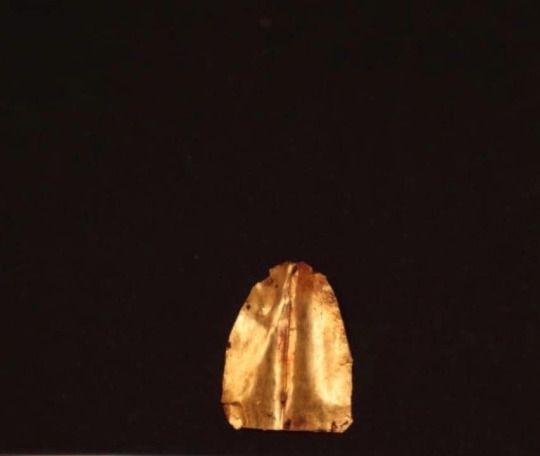
The territory became a province of the Roman Empire, which eventually divided into a western and eastern portion—with Egypt belonging to the latter. The Roman period ended around A.D. 641 when Arab forces conquered Egypt.
The latest excavations at Oxyrhynchus took place in November and December 2023. Over the course of these investigations, Pons Mellado, Mascort and colleagues discovered several tombs from the Greco-Roman era, as well as human remains and artifacts.
The finds include two tombs dating to the Roman period, built with limestone blocks. In these tombs, the archaeologists uncovered more than 20 mummified individuals covered in multi-colored wrappings, as well as papyri with Greek texts and mud seals with Egyptian iconography.
Two of these mummies were found to have pieces of gold shaped into the form of a human tongue placed where their real tongue was. Such golden tongues have previously been found at Oxyrhynchus and, indeed, other archaeological sites in Egypt.


"Until now we have found 16 golden tongues in Oxyrhynchus," Pons Mellado and Mascort said.
Experts think the ancient Egyptians may have placed gold tongues on some human remains to enable the spirits of the deceased to communicate with Osiris—the god of the underworld—and to help them cross into the afterlife.
"The Egyptian people deposited the golden tongues on the tongue to restore vital functions to the dead and also so that the body remained intact in the afterlife. For the Egyptians, gold was the flesh of the gods," Pons Mellado and Mascort said.
In addition to the Roman-era tombs, the archaeologists also discovered three "hypogea"—or underground tombs—dating to the Ptolemaic period that had been excavated beneath the natural rock.
In these hypogea, the researchers uncovered several more mummies covered in colorful wrapping, a number of anthropomorphic stone sarcophagi (some of which were closed) and various terracotta statues depicting the goddess Isis-Aphrodite, among other artifacts. This deity is a form of the Egyptian goddess Isis combined with the fertility aspects associated with the Greco-Roman goddess Aphrodite.


In one of the hypogea, the team also found many multi-colored limestone blocks with decorations, including depictions of humans, snakes, pigeons and plants.
All these findings are very important for the history of the funerary world in Oxyrhynchus," Pons Mellado and Mascort said.
"It is the first time that we have found an Oxyrhynchus terracotta with the image of Isis-Aphrodite, and the first time that this kind of piece has appeared in this area of Middle Egypt. The limestone blocks with decoration [are also very important]."
The limestone blocks—another new finding at Oxyrhynchus—appear to have come from some kind of construction, although the nature of the structure is unclear.
By Aristos Georgiou.
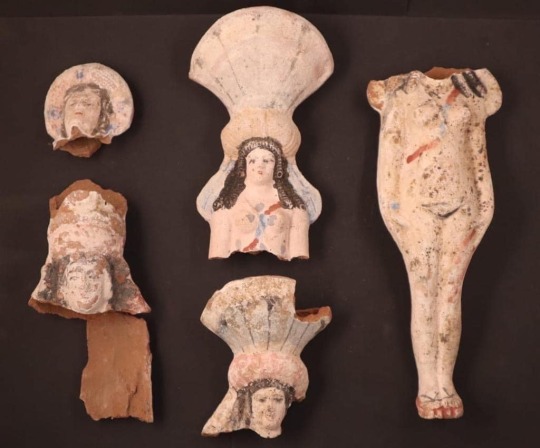

#Archaeologists Unearth Mummies with Golden Tongues in Egypt#ancient city of Oxyrhynchus#Greco-Roman period#ancient graves#ancient tombs#ancient artifacts#archeology#archeolgst#history#history news#ancient history#ancient culture#ancient civilizations#ancient egypt#egyptian history#roman history
83 notes
·
View notes
Text
Mummified Canine

The 3,500-year-old remains of a mummified canine discovered in tomb KV50 in the Valley of the Kings provide a fascinating glimpse into the relationship between ancient Egyptians and their pets.
Found with its necklace, a bowl of water and a perfume bottle, this remarkable preservation reflects the reverence afforded to the animal, believed to have been a beloved pet of Pharaoh Amenhotep II, who reigned from 1427-1401 BC.
The tomb, known as the Tomb of the Animals, lies close to the pharaoh's own burial site, reinforcing the bond between the ruler and his cherished companion.
This discovery underscores the significance of animals in Egyptian society and their deep cultural and spiritual connections.
📍Egyptian Museum, Cairo
#Valley of the Kings#Pharaoh Amenhotep II#tomb KV50#Tomb of the Animals#ancient egypt#ancient history#ancient civilizations#pets#dogs#animals#egyptian society#pharaoh#burial site#mummification#mummies#tomb#canine#mummified canine
8 notes
·
View notes
Text
Why have we as a society decided that it is perfectly alright to find and dig up the dead bodies of Ancient Egyptians, simply because its interesting.
Now I think that Ancient Egypt is interesting, infact, I have previously taken interest in the Ancient Egyptians beliefs, why they were buried the way they were, how they lived ect.
HOWEVER
I recently went to a museum as they had an Ancient Egypt exhibit, I enjoyed my experience but walked away with a dilemma. My dilemma had begun from about half way through exhibit, 2 entire rooms of the exhibit, filled with empty outter coffins, empty inner coffins and mummified human remains.
Why does anyone think it is alright to dig up dead bodies, take them from their tombs and leave their wrapped up dead bodies on display for anyone to see.
These were people, walking, talking, breathing human beings. They worked, the loved, they ate, they drank, hell they even wore makeup.
I don't think that many people would want their dead body to be placed in a museum after being dug up in an excavation.
These people have been separated from the things left in their coffins, such as prayers and heart scarabs, to protect them in the after life, their organs separated from them. Their bodies having been scanned to see what is beneath the wrappings.
One such mummy that I saw, was that of a girl, a mere 16 year old girl, who passed from disease. I stood there for a second, staring at the wrappings of her body through the glass, an unnamed, unknown girl. I tried to imagine how she would feel finding out that her body was on display, that anyone could see the her wrappings, her body not far beneath.
On the opposite side of the room, on a stand under glass was a scarab, taken from beneath wrappings, taken from the body of a person who likely believed that it could protect them in the afterlife.
On top of all of this. Many people around me were taking photos of the mummies. There is only one arguement that I have heard to "justify" taking pictures.
"Well history needs to be remembered"
History can be remembered without having to take apart someones grave, History can be remembered without having to put someones body on display, History can be remembered and taught about without disrespecting dead people.
I wish to hear what others think about about this topic.
SO
I will attach some pictures I took, no images of mummifued remains will be shown as I did not take any. However grainy filters have been added as my reflection is in many of them and I prefer to not expose my real face online.
The pictures consist of:
Organ Jars
A portrait of a man
Inner coffins (the smaller ones)
Outter coffins (the bigger ones)
A Heart scarab
A page from the book of the dead
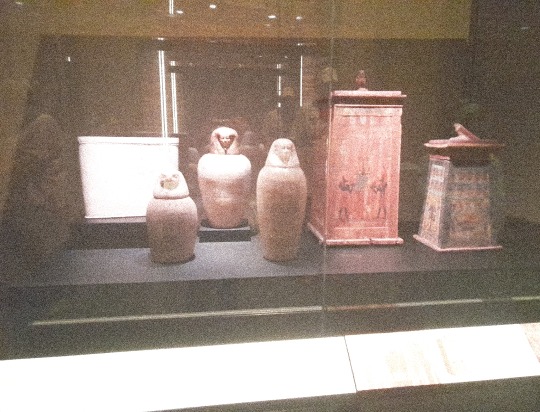
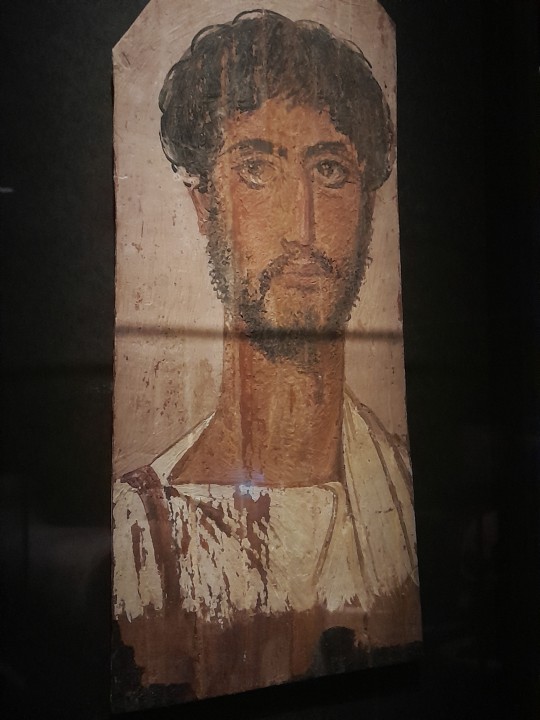

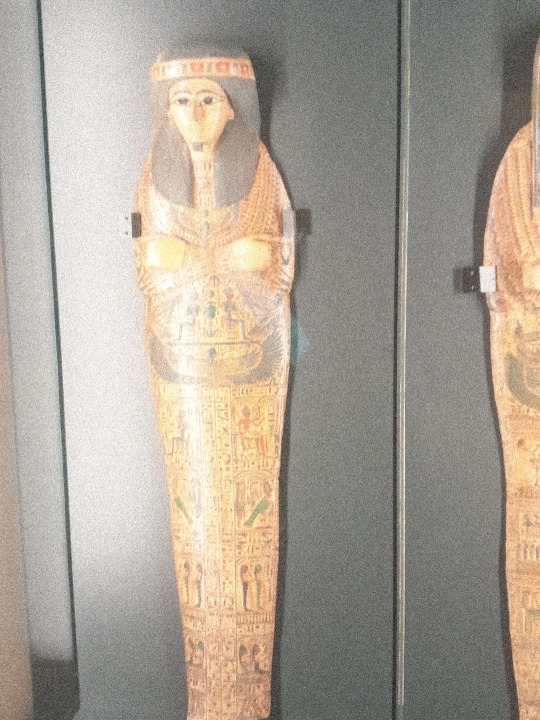
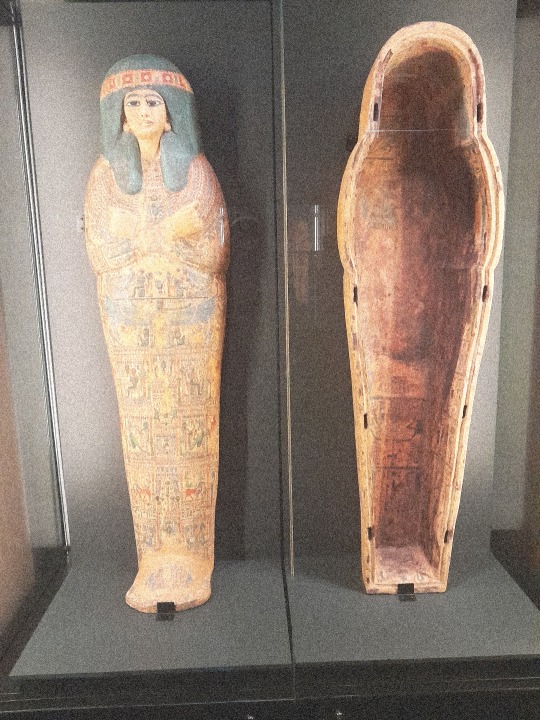

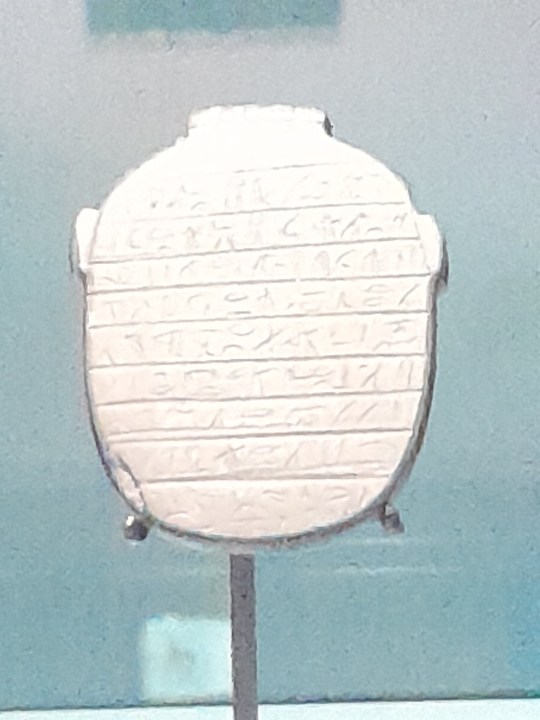
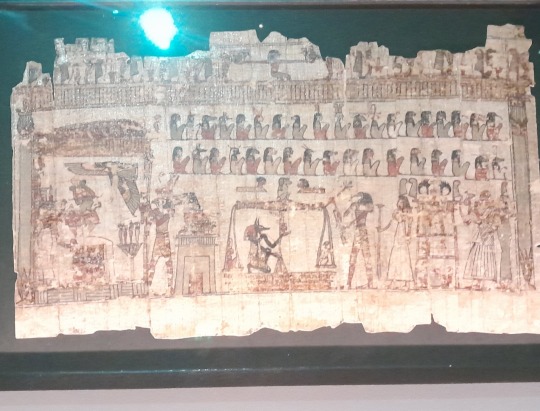
#ancient history#ancient egypt#history#opinion#i dont know how to tag stuff#historical#historic#mummies#mummification#ancient egyptian mummies#i dont like how this is delt with#be nice to me#again opinion#this is my first longer opinion post#important#morals#graves
98 notes
·
View notes
Text

Mummy of Amenhotep III
Originally buried in WV22 (Valley of the Kings), Amenhotep III's mummy was moved in ancient times to Tomb KV35, the tomb of Amenhotep II, which was used by Egyptian priests around the Third Intermediate Period as a royal "mummy" cache (storage). Tomb KV35 became a haven to protect the deceased, with priests placing royal mummies from throughout varied reigns together in one space to prevent more damage and theft from ancient tomb robberies.
Despite the rather poorly preserved condition of Amenhotep III's mummy (only his head is pictured here, but his mummified body does exist alongside his head), modern analysis of the king's remains tell us he died around aged 50, which matches Grafton Elliot Smith's estimation from over a century ago; that Amenhotep III's age at death was likely 40–50 years.
Amenhotep III now rests in the National Museum of Egyptian Civilization after being moved from the Egyptian Museum, Cairo, in April 2021.
Photo: Kenneth Garrett
Read more
186 notes
·
View notes